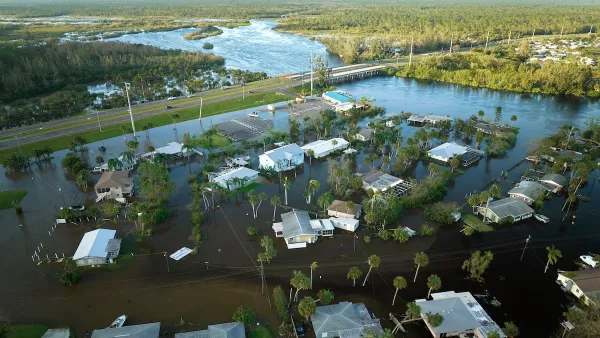A new report out this week quantifies the federal government's escalating disaster relief spending, a sum that hadn't previously been tabulated and came as a surprise to many.
"Hurricanes, floods and droughts are putting an increasingly large strain on the federal budget," reports Brad Plumer. "A new report out Monday from the Center for American Progress finds that Congress spent at least $136 billion on disaster relief between 2011 and 2013."
"Big, costly natural diasters appear to have become more frequent in the United States over the past few decades. According to the National Oceanic and Atmospheric Administration, the number of severe weather events that inflict at least $1 billion in damage (adjusted for inflation) has risen from an average of two per year in the 1980s to more than ten per year since 2010," he adds.
"There are several reasons for the rise in billion-dollar events, experts say. The U.S. population is growing, so more people live in coastal regions, on floodplains, in fire-prone forest areas, and in other high-risk places. The country is also getting wealthier, so there are pricier homes and costlier infrastructure that get damaged in floods, storms, and fires."
"But climate change has also altered at least some weather patterns."
FULL STORY: The government is spending way more on disaster relief than anybody thought

National Parks Layoffs Will Cause Communities to Lose Billions
Thousands of essential park workers were laid off this week, just before the busy spring break season.

Retro-silient?: America’s First “Eco-burb,” The Woodlands Turns 50
A master-planned community north of Houston offers lessons on green infrastructure and resilient design, but falls short of its founder’s lofty affordability and walkability goals.

Delivering for America Plan Will Downgrade Mail Service in at Least 49.5 Percent of Zip Codes
Republican and Democrat lawmakers criticize the plan for its disproportionate negative impact on rural communities.

Test News Post 1
This is a summary

Test News Headline 46
Test for the image on the front page.

Balancing Bombs and Butterflies: How the National Guard Protects a Rare Species
The National Guard at Fort Indiantown Gap uses GIS technology and land management strategies to balance military training with conservation efforts, ensuring the survival of the rare eastern regal fritillary butterfly.
Urban Design for Planners 1: Software Tools
This six-course series explores essential urban design concepts using open source software and equips planners with the tools they need to participate fully in the urban design process.
Planning for Universal Design
Learn the tools for implementing Universal Design in planning regulations.
EMC Planning Group, Inc.
Planetizen
Planetizen
Mpact (formerly Rail~Volution)
Great Falls Development Authority, Inc.
HUDs Office of Policy Development and Research
NYU Wagner Graduate School of Public Service




























